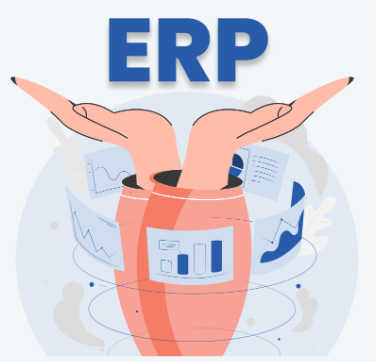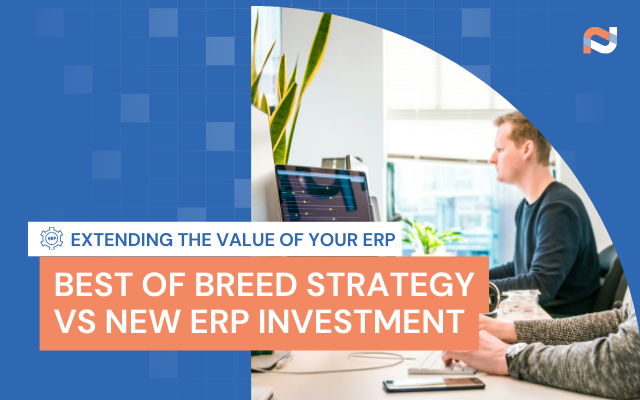ERPs are fundamental to business operations, but as companies grow, their needs evolve. Therefore businesses opt for a “best of breed” approach over a new ERP investment for upgrades.
When an ERP fails to meet these needs, organizations face a crucial choice. They can either invest in a completely new ERP system or adopt a “best of breed” approach.
In this blog, we’ll explore both paths, their benefits and drawbacks, to help you make an ERP system upgrade choice that supports your business’s growth and efficiency.
This article is part 3 in our series Extending the Value of your ERP:
- How to Solve Them with Business Analytics
- Extending Your ERP’s Capabilities with Third-Party Add-on Solutions
- Best of Breed Strategy vs. New ERP Investement

What is the “Best of Breed” Strategy?
Using a “best of breed” strategy means combining specialized software solutions meant for particular corporate processes. A “best of breed” solution offers an ERP system update for inventory management, CRM, HR, finance, or another area.
This approach allows companies to choose the best solutions for every division. Thus, without a total system overhaul, this increases functionality by means of a focused ERP system upgrade.
What Does a New ERP Investment Entail?
Making a new ERP investment entails putting in place a modern, all-in-one system that aggregates several company processes into one platform. Often modular, modern ERPs provide a consistent solution for HR, supply chain, finance, and more under one roof.
This all-encompassing strategy seeks to reduce procedures, enhance data flow, and simplify IT management.

Comparing Best of Breed and New ERP Investment
Let’s look at some of the key factors that differentiate these two strategies:
1. Cost and Resource Investment
Best of Breed: Usually, best-of-breed solutions call for less initial out-of-pocket cost than a new ERP. Often on a subscription basis, companies can adopt just the solutions they require, therefore distributing expenses over time. This strategy avoids the large cash needed for a full ERP overhaul and lets one spend gradually instead.
New ERP: A new ERP investment might be expensive. Between licenses, deployment, data migration, and staff development, the expenses mount rapidly. Furthermore, time-consuming ERP implementation often requires dedicated resources and possible downtime, which can cause disturbance of corporate operations.
2. Customization and Flexibility
Best of Breed: Among the main benefits of a best of breed approach is flexibility. As the company grows, businesses can readily replace or upgrade instruments depending on their particular requirements. This enables a great degree of customizing since every department can
New ERP: Although modern ERP investments allow for some customizing, usually their range is more limited and may call for significant development effort. ERP customizing can also affect system updates since customized configurations cannot fit fresh versions. But by offering a consistent system throughout the business, an ERP’s integrated approach does ease IT management.
3. Integration and Data Flow
Best of Breed: Combining several specialized solutions can provide problems with data flow. Every tool might have a different data format and might not naturally sync with others, therefore creating possible data silos. Though it may need more IT work, firms can close these gaps and attain a unified data flow via strong integration platforms and APIs.
New ERP: By providing flawless data flow inside one platform, new ERPs help to lower the demand for complicated integrations. Generating accurate, thorough reports is made simpler by this centralized data flow, which also helps business intelligence to have a consistent source of truth and speedier cross-departmental procedures.
4. Scalability and Future-Proofing
Best of Breed: Ideal for fast-growing enterprises, best of breed solutions let businesses add or change tools as necessary, hence providing scalability. This method guarantees that businesses may constantly have access to the newest technologies without waiting for an ERP upgrade complete.
New ERP: Though it offers a strong basis that may support significant expansion, a new ERP investment may be less flexible in the near future. Large-scale companies—those with consistent processes—may want the simplicity of an integrated ERP to help them standardize operations as they grow.
5. User Adoption and Training
Best of Breed: Best of breed solutions make training easier since every item is usually meant for a specific use. Managing several systems, nevertheless, requires staff members to learn to negotiate each one, which occasionally results in inconsistent user experience.
New ERP: Training is centralized with a new ERP system, therefore uniting users across divisions. However. given the intricacy of the technology, staff members could need intensive instruction to become platform masters. Employees may also find it more difficult to become at ease with a new all-encompassing ERP.
6. Maintenance and Support
Best of Breed: Every solution calls for different maintenance and support. Managing connections with several vendors can be time-consuming but provides access to specific knowledge for businesses. While juggling several support teams can occasionally complicate troubleshooting, a best of breed approach lets teams address particular problems with the appropriate experts.
New ERP: A single ERP investment means one vendor for support and maintenance. This lessens the difficulty of handling vendor relationships and helps to solve problems. However, depending just on one provider might occasionally cause delayed resolution times, particularly for very specialized ERP packages.
Making the Right Choice: Best of Breed vs. New ERP Investment
The decision between a best of breed strategy and a new ERP investment depends on your organization’s priorities, resources, and growth trajectory. Here are some considerations that might guide your choice:
- If your company needs specialized functionality: A best of breed approach lets you implement cutting-edge ideas for particular tasks. For instance, if the inventory control in your ERP is shallow, a third-party add-on targeted just on inventory could be the ideal solution.
- If you prioritize unified data and streamlined processes: A modern ERP system provides an integrated approach with consolidated data that facilitates departmental consistency of process execution. Companies with consistent operations and a taste for standardization could find great advantages in the simplicity of one platform.
- If cost is a critical factor: Best of breed solutions can be very affordable—especially if your operations just need to improve particular areas. However, if your ERP is significantly outdated, a new ERP might offer better long-term value, despite the upfront cost.
- If scalability is key: Businesses going through fast expansion or regular change should want best of breed for its adaptability. This strategy lets them change with the times without waiting for a complete ERP replacement.
- If you’re focused on future-proofing: An ERP offers a strong basis, but occasionally it lags behind in specific tasks as compared to fast-developing speciality solutions. More future-proof a best of breed approach would be, allowing you to leverage the newest technologies in sectors including industry-specific tools, IoT, or AI-driven analytics.
Conclusion
Both the best of breed strategy and a new ERP investment have clear benefits, and the right choice depends on your business needs. While a new ERP can streamline operations through an all-in-one platform, best of breed solutions offer customization, flexibility, and cost savings by targeting specific functional gaps.
Unlock the Full Potential of Your ERP with Business Analytics. Dive deeper into this topic with our comprehensive white paper, Extending the Value of Your Current ERP with Business Analytics.
